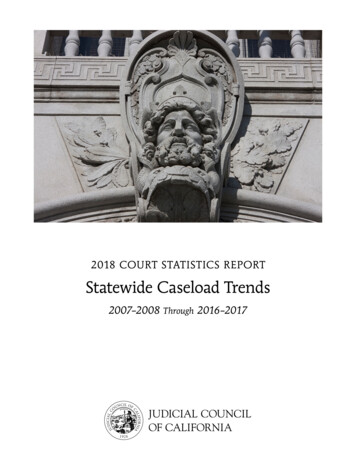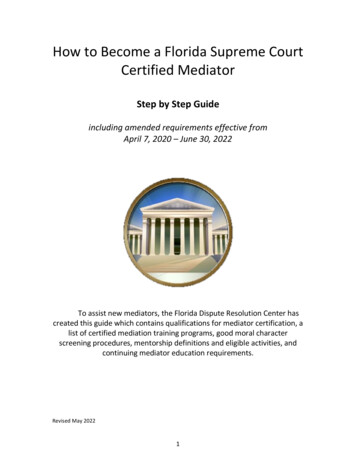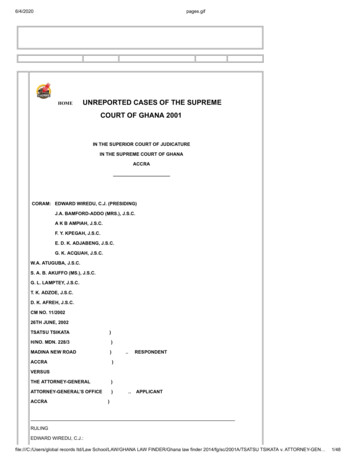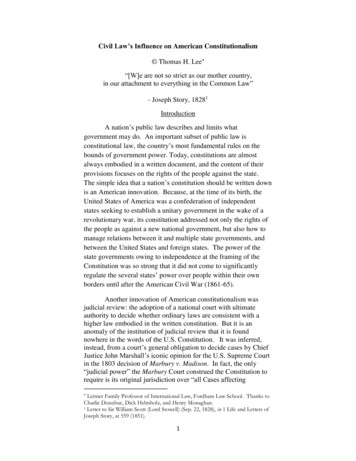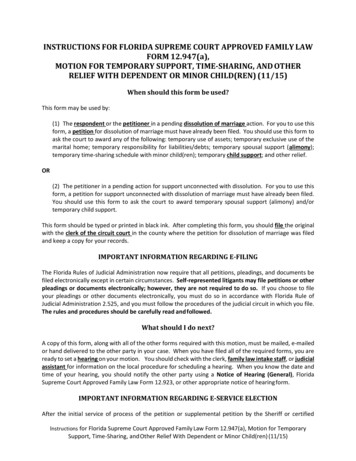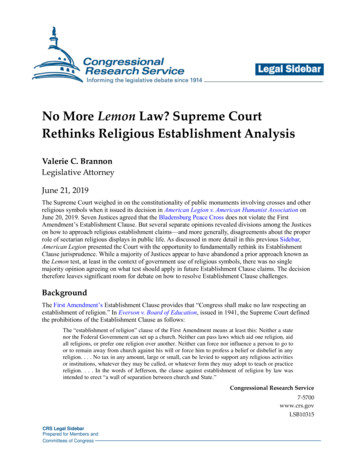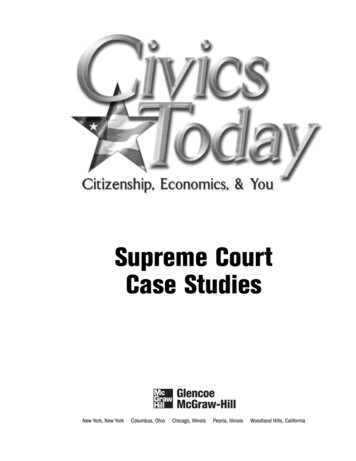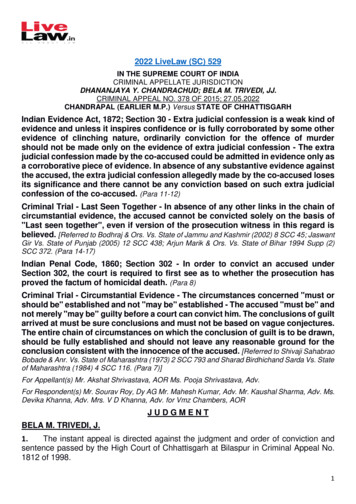
Transcription
2022 LiveLaw (SC) 529IN THE SUPREME COURT OF INDIACRIMINAL APPELLATE JURISDICTIONDHANANJAYA Y. CHANDRACHUD; BELA M. TRIVEDI, JJ.CRIMINAL APPEAL NO. 378 OF 2015; 27.05.2022CHANDRAPAL (EARLIER M.P.) Versus STATE OF CHHATTISGARHIndian Evidence Act, 1872; Section 30 - Extra judicial confession is a weak kind ofevidence and unless it inspires confidence or is fully corroborated by some otherevidence of clinching nature, ordinarily conviction for the offence of murdershould not be made only on the evidence of extra judicial confession - The extrajudicial confession made by the co-accused could be admitted in evidence only asa corroborative piece of evidence. In absence of any substantive evidence againstthe accused, the extra judicial confession allegedly made by the co-accused losesits significance and there cannot be any conviction based on such extra judicialconfession of the co-accused. (Para 11-12)Criminal Trial - Last Seen Together - In absence of any other links in the chain ofcircumstantial evidence, the accused cannot be convicted solely on the basis of"Last seen together", even if version of the prosecution witness in this regard isbelieved. [Referred to Bodhraj & Ors. Vs. State of Jammu and Kashmir (2002) 8 SCC 45; JaswantGir Vs. State of Punjab (2005) 12 SCC 438; Arjun Marik & Ors. Vs. State of Bihar 1994 Supp (2)SCC 372. (Para 14-17)Indian Penal Code, 1860; Section 302 - In order to convict an accused underSection 302, the court is required to first see as to whether the prosecution hasproved the factum of homicidal death. (Para 8)Criminal Trial - Circumstantial Evidence - The circumstances concerned "must orshould be" established and not "may be" established - The accused "must be" andnot merely "may be" guilty before a court can convict him. The conclusions of guiltarrived at must be sure conclusions and must not be based on vague conjectures.The entire chain of circumstances on which the conclusion of guilt is to be drawn,should be fully established and should not leave any reasonable ground for theconclusion consistent with the innocence of the accused. [Referred to Shivaji SahabraoBobade & Anr. Vs. State of Maharashtra (1973) 2 SCC 793 and Sharad Birdhichand Sarda Vs. Stateof Maharashtra (1984) 4 SCC 116. (Para 7)]For Appellant(s) Mr. Akshat Shrivastava, AOR Ms. Pooja Shrivastava, Adv.For Respondent(s) Mr. Sourav Roy, Dy AG Mr. Mahesh Kumar, Adv. Mr. Kaushal Sharma, Adv. Ms.Devika Khanna, Adv. Mrs. V D Khanna, Adv. for Vmz Chambers, AORJUDGMENTBELA M. TRIVEDI, J.1.The instant appeal is directed against the judgment and order of conviction andsentence passed by the High Court of Chhattisgarh at Bilaspur in Criminal Appeal No.1812 of 1998.1
2.As per the case of prosecution, the deceased Kumari Brindabai was the daughterof Bhagirathi Kumhar who belonged to the caste Kumhar. The deceased KanhaiyaSiddar was the resident of village Panjhar and belonged to the caste Siddar (Gaur). Therewas a love affair going on between Kumari Brindabai and Kanhaiya Siddar, which thesaid Bhagirathi and his brother Chandrapal did not approve. On 02.12.1994, both KumariBrinda and Kanhaiya went missing. A search was made, however, no missing report waslodged. On 11.12.1994, at about 09:00 am, Lodhu (PW-2) went to Kajubadi (CashewNursery) and saw that the dead bodies of the deceased Kumari Brinda and Kanhaiyawere hanging on a cashew tree. He therefore came back and informed the SarpanchBaran Singh Thakur. Their bodies were in decomposed state and were not identifiable,however the informant Chandrapal identified the dead bodies. Thereafter, Mergintimations were lodged by Chandrapal and Bholasingh ( PW-4) at about 16:00 hrs. and16:05 hrs. on 11.12.1994, which were registered at no. 67/94 and 68/94 respectively.The dead bodies were sent for postmortem. In the postmortem report of the deceasedKumari Brinda ( Ex. P/22), conducted by Dr. R.K. Singh (PW-13), it was opined that theligature mark over her neck was antemortem in nature, and the cause of death appearedto be Asphyxia due to hanging. In the postmortem report ( Ex. P/23) of the deceasedKanhaiya also, it was opined that the cause of death appeared to be Asphyxia due tohanging. In both the postmortem reports, it was stated that the death had occurred within8 to 10 days and the nature of the death was suicidal. As per the further case of theprosecution, on 02.12.1994, the deceased Kanhaiya was sitting at the premises of villagePanchayat, where some TV programme was going on. He, thereafter, left the said placeand went to the hand pump for rubbing his axe (gandasu). At that time the accusedChandrapal called Kanhaiya and took him to his house, shut him down in the room andall the accused i.e., Bhagirathi, Chandrapal, Mangal Singh and Videshi in furtherance oftheir common intention pressed his neck and committed his murder. Thereafter, theaccused Mangal Singh and Videshi committed the murder of Kumari Brinda. Aftercommitting their murders, they kept the dead bodies of Kanhaiya and Brinda in the houseupto 04.12.1994 and then took the dead bodies to Kajubadi. The accused thereafterhanged the dead bodies of both the deceased by tying the noose in their necks with thetree of cashew in the Kajubadi and attempted to give it the shape of their havingcommitted suicide.3.The Sessions Court framed the charge against the four accused i.e., Bhagirathi,Chandrapal, Mangal Singh and Videshi, for the offence under section 302, in thealternative under section 302 read with section 34 of IPC. Each of the accused was alsoseparately charged for the offence under section 201 read with section 34 of IPC, as alsofor the offence under section 3(2)(v) of the Schedule Caste and Schedule Tribe (Prevention of Atrocities), Act, 1989. The prosecution to bring home the charges levelledagainst the accused had examined 16 witnesses and also adduced documentaryevidence. The First Additional Sessions Judge, Raipur (Chhattisgarh), after theappreciation of the evidence on record, vide the judgement and order dated 03.08.1998,acquitted all the accused from the charges levelled against them under section 3(2)(v) ofthe SC ST Act, however, found them guilty of the offences under section 302 and 201read with section 34 of IPC. They all were sentenced to imprisonment for life for the2
offence under section 302 read with section 34 of IPC, and were directed to undergorigorous imprisonment for a period of two years for the offence under section 201 readwith section 34 of IPC.4.Being aggrieved by the judgement and order passed by the Sessions Court, theaccused Bhagirathi, Chandrapal and Mangal Singh preferred an appeal being theCriminal Appeal No. 1812 of 1998 and the accused Videshi preferred an appeal beingCriminal Appeal No. 2005 of 1998 before the High Court of Chhattisgarh at Bilaspur. TheHigh Court vide the impugned judgement and order, confirmed the conviction andsentence imposed on the accused no. 2 Chandrapal for the offence under section 302read with section 34, and under section 201 read with section 34 of IPC and accordinglydismissed the Criminal Appeal No. 1812 of 1998 qua the said accused Chandrapal.However, the High Court set aside the conviction and sentence imposed on the accusedBhagirathi Kumhar, Mangal Singh and Videshi for the offence under section 302 readwith section 34 of IPC, nonetheless confirmed their conviction for the offence undersection 201 read with section 34 of IPC, and sentenced all of them to the period alreadyundergone by them. Accordingly, the Criminal Appeal No. 1812 of 1998 and 2005 of1998 stood partly allowed. The present appellant-accused Chandrapal being aggrievedby the said judgement and order passed by the High Court has preferred the presentappeal.5.The learned counsel Mr. Akshat Shrivastava appearing for the appellant taking theCourt to the evidence of the witnesses examined by the prosecution, more particularly ofPW-2, PW-4, PW-5 and PW-6, submitted that there were major contradictions in theirevidence as regards the alleged extra judicial confession made by the accused Videshibefore them. Relying upon various decisions of this Court, he submitted that convictioncannot be based on the extra judicial confession made by the co-accused, which is of avery weak kind of evidence. Repelling the theory of ‘Last seen theory’, he submitted thatthe statement of PW1 Dhansingh who had allegedly last seen Kanhaiya, having beencalled by the present appellant, was recorded after 4 months of the incident. Even as perthe case of the prosecution, the said incident of calling Kanhaiya by the appellant was10 days prior to the date on which the dead bodies were found in the Kajubadi, and therebeing long time gap between the day the deceased was allegedly last seen with theappellant and the day when his dead body was found, it was very risky to convict theappellant solely on such evidence. He further submitted that the doctor who hadperformed the postmortem had also opined that the cause of death was asphyxia as aresult of hanging and the nature was suicidal. Thus, in absence of any clear or cogentevidence against the appellant, both the courts had committed gross error in convictingthe appellant.6.However, the learned counsel appearing for the respondent State submitted thatthere being concurrent findings recorded by the Sessions Court as well as High Courtwith regard to the guilt of the appellant, the Court may not interfere with the same. Whilefairly agreeing that an extra judicial confession would be a weak piece of evidence, hesubmitted that there was other corroborative evidence adduced by the prosecution whichconclusively proved the entire chain of circumstances leading to the guilt of the present3
appellant. According to him, after the alleged incident on 02.12.1994 , till the dead bodieswere recovered on 11.12.1994, nobody had seen the deceased Brinda and Kanhaiya inthe village, and therefore the evidence of PW-1 Dhansingh who had seen Kanhaiya lastlywith the present appellant was required to be believed, as believed by the courts below.According to him, the concerned doctor who had carried out the postmortem had alsoopined that the death of the deceased could be homicidal death also.7.At the outset, it may be stated that undisputedly the entire case of the prosecutionrested on the circumstantial evidence, as there was no eye witness to the allegedincident. The law on the appreciation of circumstantial evidence is also well settled. Thecircumstances concerned “must or should be” established and not “may be” established,as held in Shivaji Sahabrao Bobade & Anr. Vs. State of Maharashtra1. The accused“must be” and not merely “may be” guilty before a court can convict him. The conclusionsof guilt arrived at must be sure conclusions and must not be based on vague conjectures.The entire chain of circumstances on which the conclusion of guilt is to be drawn, shouldbe fully established and should not leave any reasonable ground for the conclusionconsistent with the innocence of the accused. The five golden principles enumerated incase of Sharad Birdhichand Sarda Vs. State of Maharashtra2 laid down in para 152may be reproduced herein for ready reference:“152. A close analysis of this decision would show that the following conditions must be fulfilledbefore a case against an accused can be said to be fully established:(1)the circumstances from which the conclusion of guilt is to be drawn should be fullyestablished.It may be noted here that this Court indicated that the circumstances concerned “must or should”and not “may be” established. There is not only a grammatical but a legal distinction between “maybe proved” and “must be or should be proved” as was held by this Court in Shivaji Sahabrao Bobadev. State of Maharashtra [(1973) 2 SCC 793 : 1973 SCC (Cri) 1033 : 1973 Crl LJ 1783] where theobservations were made : [SCC para 19, p. 807 : SCC (Cri) p. 1047] “Certainly, it is a primaryprinciple that the accused must be and not merely may be guilty before a court can convict and themental distance between ‘may be’ and ‘must be’ is long and divides vague conjectures from sureconclusions.”(2)the facts so established should be consistent only with the hypothesis of the guilt of theaccused, that is to say, they should not be explainable on any other hypothesis except that theaccused is guilty,(3)the circumstances should be of a conclusive nature and tendency,(4)they should exclude every possible hypothesis except the one to be proved, and(5)there must be a chain of evidence so complete as not to leave any reasonable ground for theconclusion consistent with the innocence of the accused and must show that in all human probabilitythe act must have been done by the accused.”8.It is also needless to reiterate that for the purpose of proving the charge for theoffence under Section 302, the prosecution must establish “homicidal death” as a primaryfact. In order to convict an accused under Section 302, the court is required to first see12(1973) 2 SCC 793(1984) 4 SCC 1164
as to whether the prosecution has proved the factum of homicidal death. So far as thefacts of present case are concerned, the evidence of PW-13 Dr. R.K. Singh, who hadcarried out the post-mortem of the deceased Brinda and Kanhaiya, would be mostrelevant in this regard. He had stated in his deposition before the court, inter alia, that on12.12.1994, he had carried out the post-mortem of Kumari Brinda, daughter ofBhagirathi, and of Kanhaiya alias Chandrashekhar Gaur. The dead bodies of both thedeceased were in decomposed state. He had further stated that the knot mark presenton the neck of the deceased Brinda was ante-mortem, and that the cause of deathappeared to be Asphyxia due to hanging. The death had taken place within 8 to 10 daysand the nature of death was Suicidal. The said Doctor had stated similar facts forKanhaiya that the dead body of Kanhaiya was found bent towards left side from his neckand a ligature mark having size 10 ” x 5” was present on the neck. The cause of deathappeared to be Asphyxia due to hanging and the death appeared to have taken placewithin 8 to 10 days. He had further stated that there was neither fracture found on thedead bodies of the deceased, nor any blood clots were found, nor any injuries werefound, and therefore he had opined that the cause of death was hanging which normallyis found in case of suicide. He specifically stated that as the dead bodies weredecomposed, he could not express any opinion whether it was a homicidal death. In thecrossexamination by the learned counsel for the accused, he had categorically admittedthat he did not find any symptom of homicidal death, nor he had opined in his report givenon 12.12.1994 that the deaths of the deceased were homicidal. Of course, he had statedthat on the basis of the report submitted on 30.04.1995, an inference could be drawn thatthe deaths could be homicidal deaths.9.It is worth noting that the High Court in the impugned judgment has not consideredat all the evidence of Dr. R.K. Singh to come to the conclusion whether the deaths werehomicidal deaths, before confirming the conviction of the appellant for the offence underSection 302 IPC. Unfortunately, the Sessions Court also in para 23 of its judgmentobserved that the statement of Dr. R.K. Singh was not important because he hadexpressed an opinion which was neither beneficial to the prosecution nor to the defence.In our opinion, when the case of the prosecution rested on circumstantial evidence, itwas imperative for the prosecution to prove beyond reasonable doubt that the deaths ofthe deceased were homicidal deaths and not suicidal, more particularly when the line ofdefence of the accused was that the Brinda and Kanhaiya had committed suicide, andwhen Dr. R.K. Singh who had carried out their post-mortems had also opined that thenature of their deaths was Suicidal.10. This takes the court to examine the incriminating evidence relied upon by theprosecution, that is the extra judicial confession made by the coaccused Videshi.According to the prosecution, the accused Videshi had made self-inculpatory confessionbefore the PW-4 Bhola Singh and also made confession before the PW-5Chandrashekhar, PW-6 Baran Singh and PW-7 Dukaluram, involving the other accusedincluding the present appellant. The prosecution had also produced an affidavit ofVideshi (ExP/11) allegedly affirmed before the Notary. Though the Sessions Court relyingupon the said evidence of extra judicial confession of Videshi convicted all the fouraccused, the High Court partly believing the said extra judicial confession, acquitted the5
three accused i.e., Bhagirathi, Mangal Singh and Videshi from the charges levelledagainst them under Section 302 read with 34 of IPC, however convicted them for theoffence under Section 201 read with 34 by holding that the said accused had tried tocause disappearance of the evidence.11. At this juncture, it may be noted that as per Section 30 of the Evidence Act, whenmore persons than one are being tried jointly for the same offence, and a confessionmade by one of such persons affecting himself and some other of such persons isproved, the court may take into consideration such confession as against such otherperson as well as against the person who makes such confession. However, this courthas consistently held that an extra judicial confession is a weak kind of evidence andunless it inspires confidence or is fully corroborated by some other evidence of clinchingnature, ordinarily conviction for the offence of murder should not be made only on theevidence of extra judicial confession. As held in case of State of M.P. Through CBI &Ors. Vs. Paltan Mallah & Ors.3, the extra judicial confession made by the coaccusedcould be admitted in evidence only as a corroborative piece of evidence. In absence ofany substantive evidence against the accused, the extra judicial confession allegedlymade by the co-accused loses its significance and there cannot be any conviction basedon such extra judicial confession of the co-accused.12. In Sahadevan & Anr. Vs. State of Tamil Nadu4, it was observed in para 14 asunder :“14. It is a settled principle of criminal jurisprudence that extra-judicial confession is a weak pieceof evidence. Wherever the court, upon due appreciation of the entire prosecution evidence, intendsto base a conviction on an extra-judicial confession, it must ensure that the same inspires confidenceand is corroborated by other prosecution evidence. If, however, the extra-judicial confession suffersfrom material discrepancies or inherent improbabilities and does not appear to be cogent as per theprosecution version, it may be difficult for the court to base a conviction on such a confession. Insuch circumstances, the court would be fully justified in ruling such evidence out of consideration.”The said ratio was also reiterated and followed by this court in cases of JagroopSingh Vs. State of Punjab5, S.K. Yusuf Vs. State of West Bengal6 and Pancho Vs.State of Haryana7 , wherein it has been specifically laid down that the extra judicialconfession is a weak evidence by itself and it has to be examined by the court with greatercare and caution. It should be truthful and should inspire confidence. An extra judicialconfession attains greater credibility and evidentiary value if it is supported by chain ofcogent circumstances and is further corroborated by other prosecution evidence. In theinstant case it is true that the coaccused Videshi had allegedly made self-inculpatoryextra judicial confession before the PW-4 Bhola Singh, and had made extra judicialconfession before the other witnesses i.e., PW-5 Chandrashekhar, PW-6 Baran SinghThakur and PW-7 Dukaluram stating, inter alia, that the other three accused i.e.,Bhagirathi, Chandrapal and Mangal Singh had committed the murder and he (i.e.3(2005) 3 SCC 169(2012) 6 SCC 4035(2012) 11 SCC 7686(2011) 11 SCC 7547(2011) 10 SCC 16546
Videshi) was asked to assist them in disposing the dead bodies and concealing theevidence. However, the High Court, considering the inconsistency between the said twoextra judicial confession made by the co-accused Videshi, did not find it safe to convictthe other accused i.e., Bhagirathi, Mangal Singh and Videshi himself, and the High Courtsurprisingly considered the said extra judicial confession made by Videshi as anincriminating circumstance against the appellant Chandrapal for convicting him for theoffences charged against him. In our opinion if such weak piece of evidence of the coaccused Videshi was not duly proved or found trustworthy for holding the other coaccused guilty of committing murder of the deceased Brinda and Kanhaiya, the HighCourt could not have used the said evidence against the present appellant for thepurpose of holding him guilty for the alleged offence.13. This takes the court to examine the theory of “Last seen together” propounded bythe prosecution. As per the case of prosecution, PW-1 Dhansingh had seen the accusedChandrapal calling the deceased Kanhaiya and taking him inside his house on the fatefulnight. Apart from the fact that the said Dhansingh had not stated about the time or datewhen he had lastly seen Kanhaiya with Chandrapal, even assuming that he had seenChandrapal calling Kanhaiya at his house when he was sitting at the premises of villagepanchayat, the said even had taken place ten days prior to the day when the dead bodiesof the deceased were found. The time gap between the two incidents i.e., the day whenDhansingh saw Chandrapal calling Kanhaiya at his house and the day Kanhaiya’s deadbody was found being quite big, it is difficult to connect the present appellant with thealleged crime, more particularly when there is no other clinching and cogent evidenceproduced by the prosecution.14. In this regard it would be also relevant to regurgitate the law laid down by this courtwith regard to the theory of “Last seen together”.15. In case of Bodhraj & Ors. Vs. State of Jammu and Kashmir8, this court held inpara 31 that:“31. The last-seen theory comes into play where the time-gap between the point of time when theaccused and the deceased were last seen alive and when the deceased is found dead is so smallthat possibility of any person other than the accused being the author of the crime becomesimpossible .”16. In Jaswant Gir Vs. State of Punjab9, this court held that in absence of any otherlinks in the chain of circumstantial evidence, the accused cannot be convicted solely onthe basis of “Last seen together”, even if version of the prosecution witness in this regardis believed.17. In Arjun Marik & Ors. Vs. State of Bihar 10 , It was observed that the onlycircumstance of last seen will not complete the chain of circumstances to record thefinding that it is consistent only with the hypothesis of the guilt of the accused, andtherefore no conviction on that basis alone can be founded.8(2002) 8 SCC 45(2005) 12 SCC 438101994 Supp (2) SCC 37297
18. As stated hereinabove, in order to convict an accused under Section 302 IPC thefirst and foremost aspect to be proved by prosecution is the factum of homicidal death. Ifthe evidence of prosecution falls short of proof of homicidal death of the deceased, andif the possibility of suicidal death could not be ruled out, in the opinion of this court, theappellantaccused could not have been convicted merely on the basis of the theory of“Last seen together”.19. Ergo, having regard to the totality of evidence on record, the court is of the opinionthat the High Court had committed gross error in convicting the appellant-accused for thealleged charge of 302 read with 34 of IPC, relying upon a very weak kind of evidence ofextra judicial confession allegedly made by the co-accused Videshi, and relying upon thetheory of “Last seen together” propounded by the PW-1 Dhansingh. It is also significantto note that no evidence worth the name as to how and by whom the deceased Brindawas allegedly murdered was produced by the prosecution. Under the circumstances, itis required to be held that the prosecution had miserably failed to bring home the chargeslevelled against the appellant-accused beyond reasonable doubt. The suspicionhowsoever strong cannot take place of proof.20. For the reasons stated above, the appeal deserves to be allowed and isaccordingly allowed. The appellant-accused Chandrapal is acquitted from the chargeslevelled against him. He is directed to be set free forthwith.21. Office is directed to do the needful and to send the copy of the order to theconcerned jail authority at the earliest. All Rights Reserved @LiveLaw Media Pvt. Ltd.*Disclaimer: Always check with the original copy of judgment from the Court website. Access it here8
1 2022 livelaw (sc) 529 in the supreme court of india criminal appellate jurisdiction dhananjaya y. chandrachud; bela m. trivedi, jj. criminal appeal no. 378 of 2015; 27.05.2022


